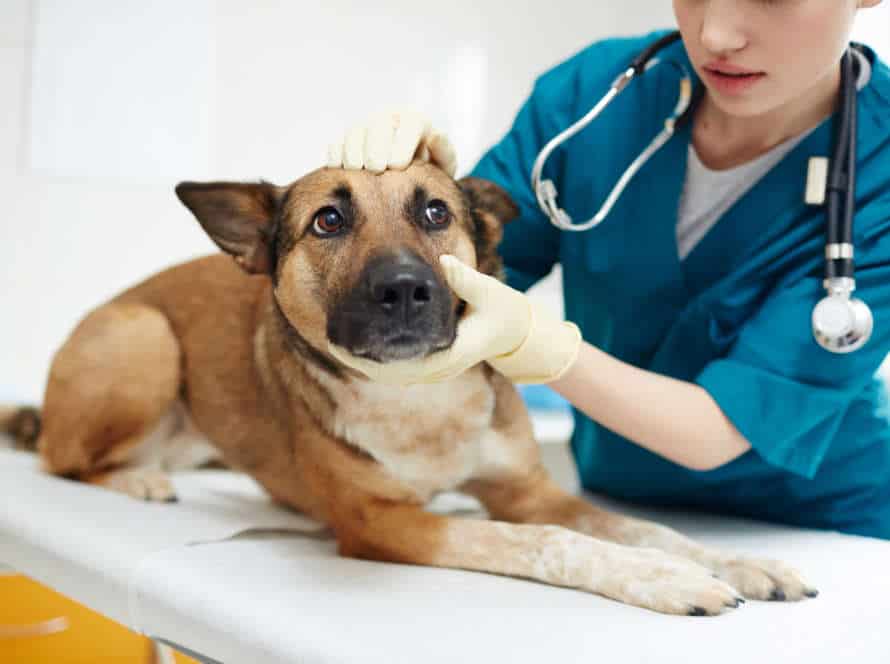Understanding Breed-Specific Health Issues
Knowing breed-specific health issues is essential for pet owners. This can help spot potential medical problems and give timely care.
Examples:
- Bulldogs usually have breathing troubles due to their flat snouts.
- German Shepherds can get hip and elbow dysplasia, which can cause joint pain and movement issues.
- Maine Coon cats might develop heart disease like hypertrophic cardiomyopathy, leading to heart failure.
- Beagles tend to be overweight and get obesity-related health issues like diabetes and joint troubles.
It’s important to research and understand your pet’s breed health issues. Also, keep a close eye on their health and get veterinary care when needed.
Common Health Issues in Dogs
It’s essential to comprehend common health issues in dogs if you’re a responsible pet parent. Like us humans, canines have a range of health issues that can hit them. Some are due to their breed and genes, while others are connected to their lifestyle choices. Knowing common health issues in dogs can help pet owners diagnose and treat any health problems their furry friend may have.
How Do Breed-Specific Health Issues arise?
Certain breeds of dogs can suffer from health issues related to their genetics and the methods used to achieve certain physical traits. This can be a result of breeding practices over time. Here are some examples:
- Bulldogs, due to their flat faces and narrow nostrils, may suffer from breathing difficulties, skin infections, hip dysplasia, and dental issues.
- German Shepherds can be affected by hip dysplasia, digestive issues, and various types of cancer due to their size, weight, and genetics.
- Dachshunds, as they have long bodies and short legs, are at high risk of spinal issues, such as intervertebral disc disease.
- Poodles may experience eye disorders, such as cataracts and progressive retinal atrophy, and may also suffer from hip dysplasia.
Owners of specific breeds of dog need to be conscious of potential health issues and take steps to prevent or treat them promptly to ensure their pet’s wellbeing.
The Role of Genetic Predisposition
Genetics have a massive influence on a dog’s health. Certain breeds possess a genetic aptitude for particular health issues. For instance, Labrador Retrievers are liable to hip dysplasia and ear infections. Whereas, German Shepherds have a higher risk of developing elbow dysplasia and cataracts.
Owners of purebred dogs should look into any health issues linked to their breed. They should take necessary precautions such as regular check-ups, exercise control and a balanced diet to avoid or reduce the effect of breed-specific health conditions.
It is essential to bear in mind that while genetics may raise the chance of certain conditions, environmental factors can too. Early detection and treatment can considerably boost a dog’s life quality.
Behavioral and Environmental Factors that contribute to health issues
Behavioral and environmental factors can cause health issues in dogs. Knowing these can help owners stop them happening.
- Diet: Not getting the right nutrients can cause digestive, obesity and coat problems.
- Exercise: Not enough exercise leads to diseases like obesity, joint and heart problems.
- Environment: Toxins and poor hygiene can create health issues.
- Genetics: Some breeds have a greater chance of health issues passed down through generations.
To keep dogs healthy, look after their diet, exercise, environment and get vet checks.
Understanding Breed-Specific Health Issues
Grasping the health problems linked with purebred and mixed-breed dogs can prove hard. Variations in health risks are connected to both genes and lifestyle, depending on the breed. This article will analyze the wide array of health issues that may be relevant to a specific breed. Plus, we’ll give advice on how to handle them.
Breeds with Hip Dysplasia
Hip dysplasia is a genetic issue. It affects certain dog breeds. It causes their hip joint to not develop correctly. This leads to mobility problems and pain. German Shepherds, Labrador Retrievers, Rottweilers, and Great Danes are some breeds prone to it.
If your pup belongs to one of these breeds, look after them! Exercise, good diet, and regular vet visits are key. Ask your breeder for hip health clearances before getting the pup.
With the right care and attention, dogs with hip dysplasia can live great lives.
Symptoms and Treatment of Hip Dysplasia
Hip dysplasia is common in certain breeds, such as German Shepherds, Labrador Retrievers, and Bulldogs.
Symptoms may include stiffness, difficulty moving, limping, and a lack of interest in exercise or stairs.
Treatment options include medication, physical therapy, weight management, surgery, and alternative therapies like acupuncture or chiropractic care.
If you feel your pup has hip dysplasia, consult your vet for the best plan. Regular check-ups and preventive care can help and improve your dog’s wellbeing.
Preventing Hip Dysplasia in Breeds that are Prone to It
Hip dysplasia is a common health issue in some dog breeds. You can take steps to stop it. Here they are:
-
Pick a good breeder. Choose one with a good record of breeding dogs with good hip scores and who checks their dogs for hip dysplasia.
-
Make your dog exercise. Managing its weight and exercising regularly can help avoid hip dysplasia. Swimming is great low-impact exercise for dogs likely to get hip dysplasia.
-
Supply your dog’s diet with supplements. Look for food and supplements that keep joints healthy, such as glucosamine and chondroitin.
-
Control your dog’s weight. Obesity can cause hip dysplasia, so keep your dog’s weight healthy.
-
Talk to your vet. It’s important to work with your vet to monitor your dog’s health and spot any signs of hip dysplasia quickly. Your vet may suggest other preventive measures for your dog’s needs.
Breeds with Brachycephalic Airway Syndrome
Brachycephalic Airway Syndrome (BAS) is a serious health issue. It affects brachycephalic breeds of dogs and cats – those with a flat, shortened skull and short snouts.
Dogs more likely to have BAS:
- English bulldogs
- French bulldogs
- Pugs
- Boston terriers
- Pekingese
- Cavalier King Charles spaniels
- Shih Tzu
- Boxers
Cats more likely to have BAS:
- Persians
- Himalayans
- Exotic Shorthairs
These breeds have narrowed nostrils, elongated soft palates, and other breathing issues. So, it’s important to watch out for signs of BAS like excessive panting, noisy breathing, and exercise intolerance.
To prevent symptoms, give your pet extra care. Regular grooming, cleaning their nostrils, and avoiding extremes in temperature can help.
Symptoms and Treatment of Brachycephalic Airway Syndrome
Brachycephalic Airway Syndrome (BAS) affects flat-faced dog breeds. It can have severe symptoms, which include noisy breathing, wheezing, snoring, panting, and coughing. Collapses and fainting may occur in severe cases.
Treatment may involve meds, lifestyle changes, and surgery. Meds like bronchodilators, steroids, and antibiotics can help. Lifestyle changes like weight management and avoiding triggers can help the dog’s breathing. Surgery like rhinoplasty or laryngeal sacculectomy might be needed.
Recognizing the disorder early and seeking veterinary care is important to avoid complications.
Tip: Preventing obesity and managing weight, avoiding strenuous activity in hot and humid weather, providing water and rest, and regular checkups can help manage and prevent BAS.
Preventing Brachycephalic Airway Syndrome in Breeds that are Prone to It
BAS is a common condition found in dogs with brachycephalic skulls, e.g. bulldogs, pugs and Boston terriers. To reduce the risks of BAS, some preventive measures can be taken.
- Avoid exercising excessively, especially in hot/humid weather – it can make breathing difficult.
- Keep your dog at a healthy weight – overweight dogs are more prone to breathing problems.
- Feed smaller meals more often, instead of one big meal. This reduces the risk of choking/vomiting.
- Use a harness instead of a collar to avoid putting pressure on the neck, which worsens respiratory issues.
- Regular check-ups with a vet can help detect breathing problems early, preventing them from getting serious.
Breeds with Predisposition to Obesity
Certain breeds of dog are genetically predisposed to obesity, which can have a serious effect on their health and lifestyle. Knowing these particular health issues can help owners take preventative steps to keep their pet fit and well.
Here are some breeds at risk:
- Labrador Retriever: These dogs have a liking for food, so careful monitoring is necessary to avoid obesity. Owners should restrict treats and make sure their Labs get plenty of exercise.
- Beagle: Beagles can be prone to overeating due to their large appetite. Owners must measure their dog’s food and provide regular physical activities.
- Dachshunds: This breed has a slower metabolism, so they gain weight easily. Owners should feed their Dachshunds small meals regularly and do plenty of exercise with them.
- Basset Hound: The lower activity level of Basset Hounds can make them more prone to weight gain. Owners need to ensure their dogs get enough exercise and not give them too many treats.
- Cocker Spaniel: This breed loves treats and is also quite susceptible to obesity. Owners should watch their dog’s weight carefully and reduce treats.
Symptoms and Treatment of Obesity in Breeds Prone to It
Obesity is a major health concern that affects some dog breeds more than others. It’s important to know the signs and how to treat it in breeds that are more likely to suffer from it.
Signs of obesity in canines include:
- less energy
- breathing issues
- panting excessively
- difficulty with jumping or going up stairs
If you see any of these signs, it’s essential to tackle the problem quickly to stop further health issues.
Treatment consists of:
- doing more exercise
- cutting back on calories, and
- switching to a healthier diet
Remember to talk to your vet before making changes to your pup’s lifestyle or food plan.
Keeping your doggy in shape is essential for their overall health and can prevent many breed-specific health problems linked to obesity, such as joint troubles, breathing issues, and heart disease.
Preventing Obesity in Breeds that are Prone to It
Obesity is a major concern for many pooch breeds. Especially those more likely to gain weight. To avoid potential health issues, it’s important to understand breed-specific health issues. Here are some helpful tips:
- Research your pup’s breed and learn about their health issues, including weight gain.
- Speak to your vet to know your dog’s ideal weight and calorie needs.
- Set up a feeding schedule and stick to it. Measure out portions and avoid overfeeding.
- Make sure your pup gets enough exercise – tailored to their age and physical ability.
- Limit treats and offer low-calorie snacks instead.
By being proactive about your dog’s health, you can help prevent obesity and increase their lifespan.
Breeds with Predisposition to Eye Conditions
Unfortunately, certain dog breeds have a greater chance of developing eye conditions. Knowing which breeds are likely to suffer from these issues can help you prepare. Here are some:
- Australian Shepherd: Cataracts, Progressive Retinal Atrophy & Collie Eye Anomaly.
- Beagle: Cherry Eye, where a gland protrudes from the eye.
- Bulldog: Cherry Eye, Entropion & Ectropion.
- Cocker Spaniel: Cataracts & Progressive Retinal Atrophy.
- Siberian Husky: Cataracts, Corneal Dystrophy & Progressive Retinal Atrophy.
Regular eye exams can help detect and prevent potential eye issues in these breeds.
Symptoms and Treatment of Eye Conditions in Breeds that are Prone to It
Certain dog breeds have higher chances of eye conditions. These can cause pain, discomfort, and even blindness. Identifying the signs and getting treatment is key to keeping your pup healthy and happy.
Here are common eye conditions and their solutions:
- Cataracts: Cloudy eyes, difficulty seeing, and eye rubbing. Medication or surgery aids.
- Cherry Eye: Swelling and redness in the eye. Surgery to reposition the gland helps.
- Entropion: Tearing, squinting, and eye rubbing. Surgery fixes the eyelid position.
- Glaucoma: Redness, swelling, and pain. Treatment includes medication, surgery, or both.
Regular eye exams and proper grooming can also help prevent these conditions.
Preventing Eye Conditions in Breeds that are Prone to It
Certain breeds of dogs tend to be more prone to eye conditions. As a pet owner, it’s important to take preventive measures. Here are some tips:
- Regular Vet Checkups: Make sure your pup gets regular eye checkups with a vet who can detect issues early.
- Healthy Diet: Feeding your pup a balanced and healthful diet is key for their overall health, including eyes.
- Avoid Irritants: Limit smoke, dust, and other airborne irritants as they can cause inflammation and infections.
- Clean Eyes: Clean your pup’s eyes with saline solution to prevent infection or buildup of debris.
- Stay Vigilant: Look out for unusual behaviors, such as excessive scratching or pawing at eyes, and take care of them right away.
By following these tips, you can help stop eye conditions in breeds that are prone to it. Plus, research your breed’s unique health issues and be proactive in preventing them!
The Importance of Identifying Breed-Specific Health Issues
Breed-specific health issues are a reality. It’s key to understand them. Without insight, owners can’t prepare or manage their pup’s health. It’s essential to learn about risks and implications related to certain breeds. This can’t be overstated!
Potential Health Concerns of Mixed Breed Dogs
Mixed breed dogs have fewer health issues than purebreds, but certain concerns remain. These include:
- Hip Dysplasia – causing joint pain and weakness.
- Progressive Retinal Atrophy – a group of diseases that lead to blindness.
- Obesity – over 50% of US dogs are overweight or obese.
- Allergies – skin, respiration and digestion problems.
Knowing mixed breed specific health issues helps with better care. Regular vet visits and healthy diets keep Fido fit and content!
Importance of Knowing Your Dog’s Breed and Associated Health Risks
Identifying your pooch’s breed and accompanying health issues is key in providing them with top-notch care. Each breed has its own unique risks; keep an eye on your pup and take preventative measures to avoid potential illnesses.
For instance, German Shepherds are prone to hip dysplasia and Rottweilers are vulnerable to cancer. Being aware of these breed-specific health problems allows you to stay one step ahead in prevention and early detection.
Regular vet visits, preventative measures, and a balanced diet are crucial for keeping your pup healthy and increasing their lifespan. Plus, knowing the breed-specific characteristics helps you manage exercise, nutrition, and behaviour needs more effectively.
As an owner, understanding your dog’s breed-specific health issues can keep your furry friend healthy and happy for years to come.
The Role of Breed-Specific Testing in Preventing Health Issues
Breed-specific testing is essential for preventing health problems. It helps identify genetic issues that are specific to particular breeds. This is especially important for dogs bred for certain purposes, such as companionship or working dogs.
For instance, German Shepherds can suffer from hip dysplasia, a painful condition. Bulldogs have breathing issues due to their flat faces. Testing can detect these potential problems early on, so breeders can select healthy dogs for breeding. This reduces the chances of passing on genetic health issues to future generations.
Identifying breed-specific health issues enables owners to take preventive measures. This ensures their dogs live long and happy lives.
Frequently Asked Questions
1. What are breed-specific health issues?
Breed-specific health issues are medical conditions that are more commonly seen in certain breeds of dogs or cats due to their genetic makeup.
2. What are some examples of breed-specific health issues?
Examples of breed-specific health issues include hip dysplasia in German Shepherds, brachycephalic airway syndrome in Bulldogs, and deafness in Dalmatians.
3. Can breed-specific health issues be prevented?
While some breed-specific health issues cannot be completely prevented, certain measures such as genetic testing and screening, proper diet and exercise, and regular veterinary check-ups can help reduce the risk of these conditions developing in your pet.
4. How can I tell if my pet is suffering from a breed-specific health issue?
Your veterinarian can perform genetic testing and regular check-ups to determine if your pet is at risk for a breed-specific health issue. If you notice any changes in your pet’s behavior or physical appearance, it is important to bring them to the vet as soon as possible.
5. What should I do if my pet is diagnosed with a breed-specific health issue?
If your pet is diagnosed with a breed-specific health issue, your veterinarian will work with you to determine the best course of treatment and management for your pet’s specific condition. This may include medication, surgery, or other interventions.
6. Can breed-specific health issues be passed on to future generations?
Yes, some breed-specific health issues can be passed down from parent to offspring. It is important to work with a reputable breeder who tests their breeding stock for genetic health issues and takes steps to avoid breeding animals that are at risk for passing on these conditions.







